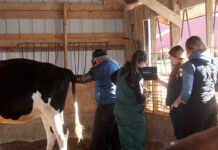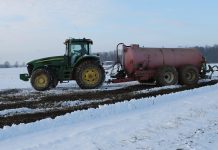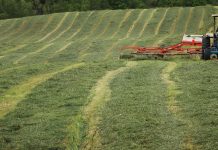
As you are out in the field (or if you’ve driven by some neighboring fields) this spring, you may have noticed vast areas with yellow blooms. What are these plants and do they make good forages?
The answer is “It depends.” There are several plant species with yellow blooms around this time of year, so you need to take a closer look to know what you are dealing with.
Wintercress
A common invader of many fields is yellow rocket (Barbarea vulgaris), also known as wintercress. This plant, like many other invasive plants, was introduced to the US as an ornamental that has since spread.
It is a biennial plant, with a basal rosette stage growing close to the ground in the first year followed by flower and seed production in the second year. The flowers you see now indicate the plant is within its second growing season. Stems are erect with ridges, growing up to two feet tall, and the showy yellow flowers are grouped in a column-like inflorescence. Livestock that feed extensively on yellow rocket may develop gastrointestinal upset.
Cressleaf groundsel
Another plant in bloom this spring that you may find in poorly managed pastures is cressleaf groundsel (Packera glabella), a plant belonging to the aster family and is one of concern for livestock. This plant produces pyrrolizidine alkaloids that are considered poisonous to herds, causing severe symptoms such as weight loss, jaundice and death in some cases. It contains a hollow stem that can grow up to three feet in height and produces yellow aster-like flowers.
Cressleaf groundsel is a winter annual, growing as a basal rosette in the fall and bolting in the spring to produce flowers and seeds. It thrives in the cooler, wet conditions of the spring season but can struggle as temperatures warm in the summer months.
One of the differences between cressleaf groundsel and yellow rocket is that the leaves of the cressleaf groundsel are round with toothed lobes while yellow rocket has large terminal lobed leaves that are smooth.
Wild parsnip
Wild parsnip will be a plant that blooms starting in May as well, although blooms occur in its second year since it’s a biennial in Ohio. It is related to cultivated parsnip, but don’t touch! Contact can make skin more sensitive to sunlight, leading to the formation of painful rashes and blisters.
Like cressleaf groundsel, it has a hollow stem (except at the nodes), but the blooms are umbel-like and not the ray and disk shapes characteristic of asters. Leaves are compound, pinnate and lobed, forming a basal rosette in its first year of growth. It can reach up to five feet in height in its second year of growth.
Birdsfoot trefoil
As we begin to enter the summer months, birdsfoot trefoil begins to produce its yellow blooms. Its seed pods resemble a bird’s foot, hence the name, and it has a creeping growth habit. Unlike the previous three plants discussed, this one can be an excellent pasture forage tolerant of poorly drained acidic soils. However, it can be challenging to seed in pastures due to its low seedling vigor and small seeds.
Before controlling or managing weeds, identification is critical. Oftentimes we depend on flower color for identification, but color can be deceiving or is only one of several characteristics that need to be examined. Paying attention to features other than flower color, such as life cycle, leaf size and shape and growth habit can lead you to a more accurate ID and better management in your fields.












